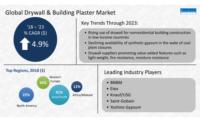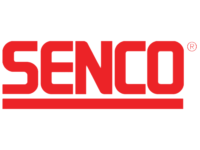Worldwide sales of drywall are forecast to expand 8.6 percent per annum through 2016 to nearly 10.7 billion square meters, a massive improvement over the 2006-2011 pace. Following recent severe losses between 2008 and 2011, drywall demand is expected to rebound sharply in North America and Western Europe. The East European market will also improve. While advances in the Africa/Mideast region, Asia/Pacific region, and Central and South America are projected to decelerate slightly through 2016, each of these regions is still expected to record impressive growth.
NORTH AMERICAN MARKET
In 2011, the drywall market in the U.S. approached 1.6 billion square meters, making the U.S. the second largest consumer of these products worldwide (behind China). The U.S. accounted for 22 percent of global drywall sales that year. The country’s extensive construction market includes both significant levels of new construction and a vast base of existing structures, both of which sustain very high levels of product demand. Additionally, wood-framed construction, which is more amenable to drywall use than other techniques, is popular in the U.S. The country also possesses massive natural gypsum reserves and many suppliers of synthetic gypsum.
Sales of drywall in the U.S. fell 13.7 percent per year during the 2006-2011 period. Residential building construction expenditures and associated drywall demand declined at a double-digit pace because of housing oversupply issues in the U.S. and the global financial crisis. Consumption also decreased because of a sizeable drop in nonresidential building construction activity. Shipments of drywall from plants in the U.S. reached 1.6 billion square meters in 2011, after declining 12.3 percent annually between 2006 and 2011. As domestic drywall sales declined, output fell sharply. Suppliers operating in the U.S. managed to boost exports to Canada and other key markets, which helped to offset a portion of the losses.
THE MARKET EVERYWHERE ELSE
In China, demand for drywall is forecast to grow nearly 12 percent per year through 2016. Comprising nearly one-fourth of global demand, the Chinese market for drywall exceeded 1.7 billion square meters in 2011. Because drywall has only been available in China since the late 1990s, the intensity of product use in the country—gauged against building construction expenditures and population size—is much lower than more industrialized countries in the Asia/Pacific region, such as Australia and Japan. Drywall is used most frequently in urban areas because local construction firms have adopted modern building techniques. Residential applications account for a much smaller portion of drywall sales than commercial, industrial, and institutional applications because of the higher cost of these products relative to traditional building materials.
From 2006 to 2011, sales of drywall in China rose nearly 22 percent per year, the fastest rate of increase worldwide. Consumption increased greatly as both residential and nonresidential building construction expenditures in the country grew 16 percent annually during the 2006-2011 period. The more frequent use of drywall in both residential and nonresidential applications also greatly contributed to drywall market gains. Residents, businesses, and government-controlled entities have become much more open to drywall products since 2006.
Numerous industrializing countries are also projected to register robust growth between 2011 and 2016, including India, Saudi Arabia, Mexico, Thailand, and Turkey. Increasing demand for urban housing will drive residential building construction spending and related drywall sales. Consumption in these countries will also grow because of advances in office and commercial construction activity. Going forward, local construction firms will increase their use of modern building materials (such as drywall) at the expense of other products (such as building plaster).
The drywall market in Western Europe is forecast to expand 3.6 percent per year, a considerable improvement over the 2006-2011 pace. Spain is expected to register the fastest growth during this period, as new residential construction activity begins to recover, even though inflation-adjusted spending in 2016 will be well below the 2006 level. Among the other major markets that are expected to perform well are Italy, France, and the United Kingdom. Drywall demand in Western Europe will rise primarily because of increases in new residential construction from a depressed 2011 level. W&C





Report Abusive Comment